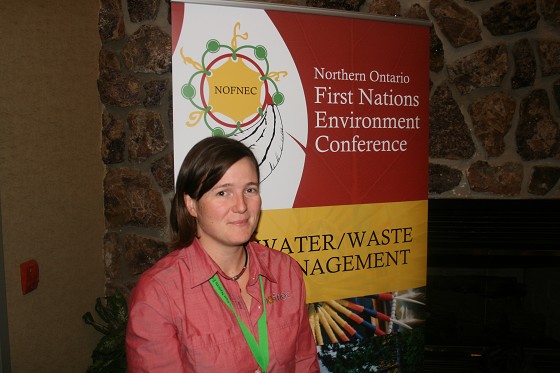First Nations Environment Conference
by Scott A. Sumner
The Fifth Annual Northern Ontario First Nations Environment Conference was held Sept 30th to Oct 2 at the Best Western Plus Nor'Westor Hotel & Conference Centre in Thunder Bay. The event was very well attended by First Nations communities throughout NW Ontario.

Lindsey Jupp is Environmental Technologist with Matawa First Nations Management
“ We started the conference in 2009 when we invited others to share environment issues in our communities. The conference is about safe drinking water including source water protection, clean and safe drinking water for the communities as well as for the animals you live on and subside on. There is also land management with contamination issues.”
“ Many of the communities of up to 1000 people and 400 homes relie on diesel for energy. You may have to access the communities by plane or ice road only so you are shipping mass quantities of diesel across sensitive areas.”
“ The communities have water treatment plants which have issues in some cases. Some of our communities have been on boiled water advisories for 25 plus years. It could be a simple solution like a new water plant but they are expensive and when you have 134 First Nation communities in Ontario alone it is expensive.”
“ We also have issues with mining where you have people coming into an area that is pristine and largely untouched and working with regulations but they may not be enforced. The Ring of Fire could be an important future for Matawa but what if your future is unsafe drinking water, contaminated lands and animals you can't eat because they have moved out or their water is contaminated. We need to come together to have everyone feel comfortable about the future.”
“ This year we are highly focused on sharing- prepare, protect and prosper. We have First Nations speakers talking about their challenges, government officials talking about their programs and private sector companies doing demonstrations on their work. Every partner has a role to play.”
“ Renewal energy has it place. Passive solar with small units can more localized say for heating of water. It will reduce the need for diesel. There are over 40 communities in the north and power lines may also affect the traditional lands. It is a long way to come yet. If you can reduce the power required by 50%, say at the water plants, you are saving hundreds of thousands of dollars. If you don’t have storage facilities for diesel fuel you have to fly it in through the year. There are funding programs available but they are limited and some aren’t successful in getting the funds. There isn’t much economic development in the community’s as well.”
“ This year we have 10 First Nation Tribal councils here which represent 60 communities which is a lot of sharing.”

Mitchell Diabo is GM of Community Development of Kasabonika FN
“ We are involved in a project with some universities and private communities integrating renewable energy into our diesel system. Our objective is to create a diversity of supply mix. We are now 100% reliant on diesel fired energy and diesel costs are increasing so are trying to stem that reliance with solar and wind.”
“ We have 4 wind turbines installed where we are trying to integrate two different energy sources so they work together to match the load when the electricity is required. There are solar panels on our water treatment plant which uses the largest amount of electricity. It has an impact on stretching our budgets. We are looking at creating solar farms. “










